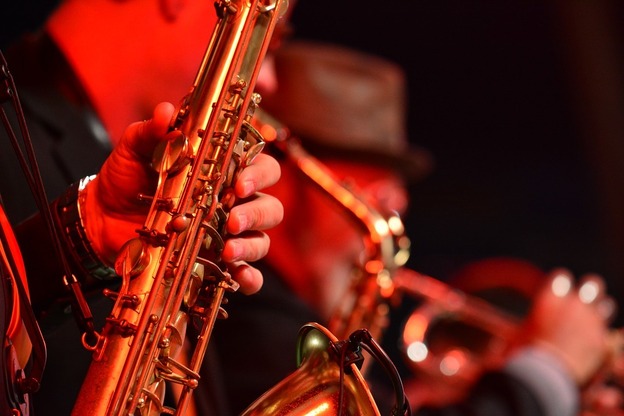|
A traditional three-piece jazz band consists of a piano or organ, double bass, and drums or another type of percussion to keep the beat. Renowned San Francisco Bay Area bassist, bandleader, and music educator Marcus Shelby offers a fine example of this standard jazz configuration in the many recordings and performances of the Marcus Shelby Jazz Trio. Shelby’s ensemble expands to accommodate different types of performances and offers excellent examples of different configurations of the jazz band. His quartet adds a trumpet, and his quintet uses all these instruments plus a tenor saxophone. A typical configuration for the full Marcus Shelby Jazz Orchestra features all these instruments and more, with two tenor sax players, two on alto sax, a flute, piano, and drums, along with several clarinets, trombones, and trumpets. This complement of more than a dozen performers often features vocalists, which is typical of all types of jazz. John Brown, another widely accomplished and popular bassist, bandleader, and educator, performs throughout his home state of North Carolina and beyond with his big band orchestra. In the standard configuration of the John Brown Jazz Orchestra, the big band sound comes from five saxophones, four trombones, and four trumpets, plus drums, piano, and bass. The orchestra also sometimes brings in a vibraphone, clarinet, violin, and vocalists. These are just two prominent examples of a universal truth: the standard jazz orchestra is a diverse group of instruments that together make beautiful music. After this tour around the full jazz orchestra, now we’ll take a look at a few of the great jazz band solos of all time: Trumpet Dizzy Gillespie (1917 - 1993), one of the greatest trumpet players the world has ever seen, and a master of bebop, delivered an especially notable trumpet solo with “Salt Peanuts.” Gillespie first performed his jazzy bebop composition (for which he shares composer credits with drummer Kenny Clarke) in 1942. He is accompanied by the great Charlie Parker playing alto saxophone. Gillespie’s integration of bebop into a jazz composition was a major innovation for its time. The song is deceptively simple and effervescent, and it moves in a typically frenetic bebop style. Gillespie’s trumpet solo weaves against the background provided by the sax, trombone, drums, and piano. The tune includes witty vocal interpolations of the phrase “salt peanuts” as the only lyrics, repeated at musically opportune moments. In later years, Gillespie’s inventiveness and stage presence earned him the nickname “Ambassador of Jazz.” He traveled the world on behalf of the United States Department of State to highlight his uniquely American art form. As he performed “Salt Peanuts” over the decades, Gillespie branched out with a number of different vocal riffs on the original. Now-classic recordings from 1945 showcase Gillespie’s performance on the piece at its best, before a traffic accident a few years later sadly injured his mouth and put limits on his range. SaxophoneCharlie “Bird” Parker’s (1920 - 1955) solo sax on “Ko Ko” is one of many jazz fans’ all-time favorites. One of the greatest improvisers and innovators of all time, Parker demonstrated a creative depth and range that easily places him alongside Ornette Coleman, Django Reinhardt, Louis Armstrong, and John Coltrane as the greatest of the great. Along with Dizzy Gillespie, he is credited as a central figure in the creation and development of bebop. “Ko Ko” represents Parker’s first-ever recorded piece as a bandleader, and he took the opportunity to show the full capacity of the bebop form, evolving its rapid-fire chord changes and high-octane melodic escapades as he played. He developed “Ko Ko” as his own personal take on the popular 1930s Ray Noble dance tune “Cherokee,” and recorded it in its essential form in 1945. On “Ko Ko,” Parker also shows off his understanding of rhythm and harmony to dazzling effect. Performing “Ko Ko” most notably accompanied by “Diz” on trumpet, Parker delivered a short tune with a simple compositional architecture. Recordings of the just-under-three-minute song give us an opening meld of sax and trumpet, followed by the two instruments exchanging eight-bar phrases to end abruptly with a final pop of sound. ClarinetBenny Goodman (1909 - 1986), one of the greatest clarinetists to ever perform, was also a noted bandleader and composer. The “King of Swing” created a wide range of now-iconic performances and developed his mastery of his instrument to a high art. One of his very early solo recordings, from 1928, offers an example of the range and power of the clarinet and Goodman’s musicianship.
This early version of “That’s a Plenty” (lyrics and music by Ray Gilbert and Lew Pollack) was recorded with piano and drum accompaniment when Goodman was not yet 20. He also recorded other performances of the song in later years. Although his playing had not yet reached its full capacity and the sound is less polished on the 1928 recording, Goodman’s raw forward drive in executing the piece is notable and exciting. A number of fans and critics point out the influence of klezmer, traditional Eastern European Jewish band music, on Goodman, who was a child of Russian Jewish immigrants. “That’s a Plenty” and many of Goodman’s other performances certainly demonstrate echoes of the elegantly winding and infinitely danceable call of the klezmer clarinet. Goodman kept playing “That’s a Plenty” in a variety of settings and with a variety of accompaniments well into his later years, including in a notable 1980 performance at the Aurex Jazz Festival in Tokyo. Comments are closed.
|
Photo used under Creative Commons from Marina K Caprara

 RSS Feed
RSS Feed
